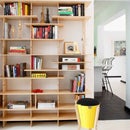Introduction: Mid-Century Modern Style Coffee Table Made With Plyboo (Bamboo Plywood)
I came upon some Plyboo, a new material made from laminated bamboo. Its a very attractive surface, with geometric end-grain. The laminate is dense, stable and quite expensive, so I didn't want to waste it.
I had just enough for a coffee table, designing a open faced, split shelf 17" H table with round tapered legs. I took my inspiration from a mid-century modern table design.
Step 1: Cut Plyboo to Size on Table Saw
I made my table 44" wide by 22" deep and 5.5" tall shelf. Using Plyboo (lovely 3/4" thick bamboo plywood)
Cut 2 x 44" x 22" pieces for top and bottom of your table
Cut 3 x 22" x 5.5" pieces for inserts.
Use push sticks for the smaller parts and remember SAFETY FIRST!!
I used a random orbital sander with 220 and 320 grit paper to sand all surfaces including edges. When necessary add a touch of hand sanding to get that lovely smooth finish.
Step 2: Picking Out Table Legs
This table was started as a quick side project, mostly because I came upon some free scraps of Plyboo. Thus, I didn't invest time turning legs on the wood lathe.
To get that "mid-century" table look, I found a place online to purchase round tapered table legs and angled brackets here www.Tablelegs.com
I order 10" legs and picked cherry wood, because bamboo is not an option and cherry seemed like the closest in color, it matched well!
Step 3: Cutting Biscuit Joints Into Table Top, Bottom and Sides.
I used this Ryobi Biscuit Jointer aka Plate Jointer ( $99 at Home Depot). It works well for the price.
It took some time figure out how to properly (fine tune) adjust the depth of the cut as my initial attempts were way off and too shallow. The 20 setting was fitting the 10 size biscuit until I turned the adjustment dial and made several test cuts to figure out the right depth. The trick is to make sure your biscuit is sinking just below the half way point.
After setting the depth to 3/4" I clamped my material, made tick marks on the inner faces of my parts and made 3 biscuit groves per edge.
Make sure you test each connection dry and that you are keeping your parts oriented correctly.
The cuts on the ply ends are very simple, see photo 1, but doing the cuts into the large sheet is a bit trickier.
Most important you do not want to rely on the jointer fence to be accurate, instead use the tools flat metal bottom to have perpendicular geometry to set up your cuts.
I built an L bracket and clamped it to my material and the table, then lifted the fence all the way up and set my tool bottom on the vertical part of the L, so my tool is nose down. See photos.
This allows me to cut down and still cut off the tool base.
Tip: Make your marks longer then 6" so you can see your line above your tool head.
Step 4: Dry Assembly, Glue and Clamping
Once all your groves are cut, do a dry assembly (no glue) of your entire table.This will ensure that everything fits and aligns. If it does - you measured well!
Now you can glue it up and strap it /clamp to dry overnight.
* Tip: Apply glue to both sides and spread with your finger or piece of paper to ensure you cover all surfaces that will touch each other, adding a bit of extra glue into the biscuit holes. The biscuits will expand and fill the entire void, essentially becoming one with your wood. I did not use any metal fasteners in this table, but you can.
* Tip: Slowly tighten the straps together making sure nothing twists or falls off course. Keep even pressure. Use a rubber mallet to gently tap the boards into place if they are misaligned.
*Tip: You can wipe off access glue with a wet rag, or use a blade to cut glue off 15-20 min after you apply it and it starts to set, but DO NOT scratch your wood.
Repeat sanding all sides with 220 and 320 after the glue sets, to make sure every transition is smooth to the touch.
Step 5: Sealing Wood and Attaching Legs
Once your table is glued and has dried overnight you can seal the wood. I wanted to keep the natural color of the bamboo and cherry so I used Waterlox a Tung oil based finish, I also recommend Rubio's Monocoat as an alternative. Both are a nice 3 in 1 finishes – penetrate, seal and finish.
I applied the Waterlox with a cotton rag, wiping it on 4 times, allowing each coat to dry in between application. Apply same amount to legs.
Pro Tip* Always wear gloves, a respirator if you have one and work outdoors or in a well ventilated area.
Attaching Legs:
Inset legs 6" in from the table end using their center as the reference point. You can screw the legs into the brackets and stand them up on the bottom surface of the table to get a feel for what they will look like once you screw them in.
Note the depth of the leg bolt when fully tightened on the bracket may exceed the plane of the bracket and scratch the table while you are marking the placement. Measure from the outer edges of the bracket to finalize placement, then mark the screw holes with a pencil, remove the legs, and screw in the brackets. Screw the legs back into the brackets and viola!
Tip* Use a protractor to set your legs at an appealing angle. Once seal is dry on all parts assemble legs and you are DONE!













